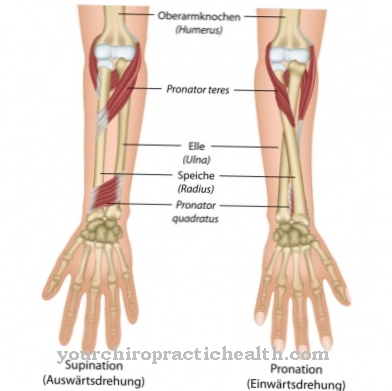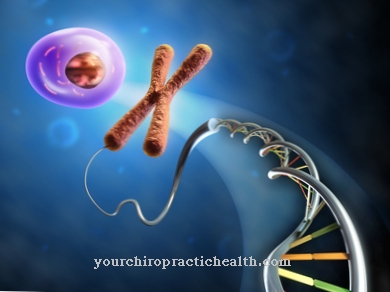The process of transcription In biology, it involves the process of replicating a section of a DNA strand into a messenger RNA strand (mRNA). The mRNA then contains the nucleic base sequence which is complementary to the part of the DNA. The subsequent transcription takes place in all eukaryotes, including humans, within the cell nucleus, while the subsequent translation, the translation of the mRNA into a specific protein in the cytoplasm, takes place on the ribosomes.
What is the transcription?

The transcription process is the first stage in the conversion of genetic information into proteins. In contrast to replication, it is not a matter of making a copy of the entire genome, but always only of certain parts of a DNA strand.
At a certain section of a DNA strand, the bond to its complementary partial strand in the double helix is first broken by breaking the hydrogen bonds. The addition of free RNA nucleotides to the area to be copied creates a new complementary section, which, however, consists of ribonucleic acids and not of deoxyribonucleic acids as in DNA.
The resulting RNA segment is practically the working copy of the DNA segment and is known as messenger RNA (mRNA). The mRNA that arises within the cell nucleus splits off from the DNA and is transported through the cell nucleus membrane into the cytosol, where translation, the conversion of the RNA codons into the corresponding amino acid sequence, i.e. the synthesis of the protein, takes place.
Sequences of three (triplet) of nucleobases on the mRNA, called codons, determine one amino acid each. According to the sequence of the mRNA codons, the corresponding amino acids are assembled into polypeptides and proteins via peptide bonds.
Function & task
In biology, transcription fulfills the first of two main processes that convert genetic information, which is present as sequences of DNA nucleobases, into the synthesis of proteins. The genetic information consists of sequences of three, so-called triplets or codons, each of which stands for an amino acid. Some amino acids can also be defined by different codons.
The function of transcription consists in the production of an mRNA strand whose nucleic bases - in this case ribonucleic bases and not deoxyribonucleic bases - correspond to the complementary pattern of the expressed DNA segment. The generated mRNA thus corresponds to a kind of negative template of the expressed gene segment, which can be used for the one-time synthesis of the encoded protein and is then recycled again.
The second main process for converting genetic information into specific proteins is translation, in the course of which amino acids are strung together according to the coding of the mRNA to form proteins and linked to one another peptidically.
Transcription enables genetic information to be read selectively and transported in the form of complementary copies out of the cell nucleus into the cytosol and, independently of the corresponding DNA segment, to build the proteins.
One of the advantages of transcription is that parts of a single DNA strand can be expressed for the production of the mRNA without the entire gene having to be exposed to constant physiological changes and thus running the risk of mutating or otherwise changing its properties.
Another advantage of transcription is the so-called splicing and other types of processing of the mRNA. The splicing process first frees the mRNA from so-called introns, from functionless codons that do not code for amino acids. In addition, adenine nucleotides can be attached to the mRNA using the enzyme poly (A) polymerase.
In humans, as in other mammals, this appendage, called the poly (A) tail, consists of about 250 nucleotides. The poly (A) tail shortens with increasing age of the mRNA molecule and determines its biological half-life. Even if not all functions and tasks of the poly (A) tail are sufficiently well known, it seems at least certain that it protects the mRNA molecule from degradation and improves the convertibility (translatability) into a protein.
Illnesses & ailments
Similar to cell division, where errors in the replication of the genome can occur, the most common problem associated with transcription is a "copy error". Either a codon is "forgotten" during the synthesis of the mRNA or an incorrect mRNA codon is created for a certain DNA codon.
It is estimated that such a copy error occurs in approximately every 1,000th copy. In both cases a protein is synthesized that integrates an unintended amino acid in at least one place. The spectrum of effects ranges from 'not noticeable' to total failure of the synthesized protein.
If a gene mutation occurs during replication or due to other circumstances, the mutated nucleus base sequence is transcribed, since the process of transcription does not include checking the codons for “correctness”.
However, the body has a well-developed DNA repair mechanism in which more than 100 genes are involved in humans. The mechanism consists in an ingenious system of immediate repair of the gene mutation or replacement of a damaged nucleic base sequence, or else the minimization of the effects if the former two possibilities are eliminated.
The fact that the transcription takes place without prior testing of the genes harbors the risk that transcription can also be involved in the spread of viruses if the viruses inject their own DNA into the host cell and cause the host cell to create the genome of the viruses, or parts thereof, by replication or transcription. These can then trigger the corresponding illness. In principle, this applies to all types of viruses.
























.jpg)



